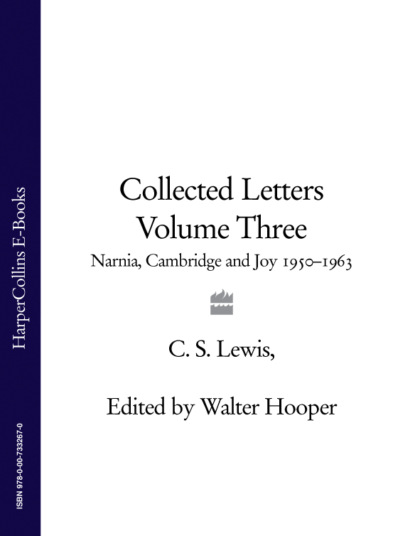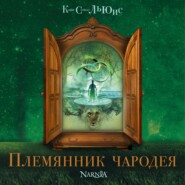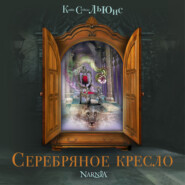По всем вопросам обращайтесь на: info@litportal.ru
(©) 2003-2025.
✖
Collected Letters Volume Three: Narnia, Cambridge and Joy 1950–1963
Настройки чтения
Размер шрифта
Высота строк
Поля
44 (#ulink_77136e5f-f376-5dd0-aa6b-02e7c2a9bd6f) See the biography of Walter Ogilvie ‘Woff Field in CL II, p. 572n. Field, like Cecil Harwood, was a teacher at Michael Hall School, Kidbrooke Park, Forest Row, Sussex.
45 (#ulink_7642a9be-aedf-57b9-9fe6-9dea3e854d53) See Roger Lancelyn Green in the Biographical Appendix to CL II, pp. 1039-43. At this time Green was living at 119 Woodstock Road, Oxford,
46 (#ulink_1b7ce110-c63f-5ebf-9d41-0aea5b679ced) Lewis’s original title for what became Prince Caspian: The Return to Narnia (1951) was ‘A Horn in Narnia’ (since it was Queen Susan’s magic horn which drew the children back to the rescue of Prince Caspian).
47 (#ulink_e35b9a82-60d7-56fd-8647-ff660aa3cb4c) See Lady Freud in the Biographical Appendix to CL II, pp. 1033-6. June Flewett (known familiarly as ‘Jill’) had been evacuated to Oxford at the beginning of the Second World War, and ended up living at The Kilns during 1943-5, helping Mrs Moore and the Lewis brothers. After graduating from the Royal Academy of Dramatic Art, London, in 1947, she became an actress, using the screen name Jill Raymond.
48 (#ulink_5c633358-1b24-59b1-bd6d-d596e781e8a7) Warnie was in Restholme on this occasion.
49 (#ulink_21a98cf5-0920-5090-a7dc-81394f1daf59) Bruce was Mrs Moore’s elderly dog.
50 (#ulink_1c400f1b-9a96-564c-8db4-a6eb11995093) This letter was published in The Times Literary Supplement (3 March 1950), p. 137, under the title ‘Text Corruptions’.
51 (#ulink_ed75e4f4-c126-54bb-a6a6-623da10a6cde) William Shakespeare, Two Gentlemen of Verona, ed. John Dover Wilson (Cambridge: Cambridge University Press, 1921).
52 (#ulink_ed75e4f4-c126-54bb-a6a6-623da10a6cde) William Shakespeare, Two Gentlemen of Verona (1594), V, iv, 90. References to Shakespeare in the present volume are to William Shakespeare, Complete Works, ed. W J. Craig, Oxford Standard Authors (Oxford: Oxford University Press, 1905).
53 (#ulink_ed75e4f4-c126-54bb-a6a6-623da10a6cde) Shakespeare, Two Gentlemen of Verona, ed. Dover Wilson, p. 103.
54 (#ulink_dec04b0a-f7ff-5a45-93b1-4be636bf43b9) See Dr Warfield M. Firor in the Biographical Appendix to CL II, pp. 1031-2.
55 (#ulink_a826d9fc-cb31-54bc-be79-7d90d86058bf) On 24 February 1950 the British Labour Party won the general election, with Clement Attlee (1883-1967) returning as Prime Minister.
56 (#ulink_0997168d-5a75-54fe-a896-08a01c5a979e) William Shakespeare, Hamlet (1603), IV, iv, 36-9.
57 (#ulink_d88898eb-eaee-5910-9a99-e29c1f625878) ‘masterpiece’.
58 (#ulink_380372f2-df87-56b9-a11f-66baadf8d5fa) ‘way to arrive’.
59 (#ulink_1846f83b-d682-5157-b856-df440a7a9493) Green had written a blurb for the cover of The Lion, the Witch and the Wardrobe (London: Bles, 1950), but in the end it was not used.
60 (#ulink_1846f83b-d682-5157-b856-df440a7a9493) See the biography of Geoffrey Bles in CL II, p. 554n. Bles, Lewis’s publisher, was the owner of Geoffrey Bles Ltd, London.
61 (#ulink_7996d60b-2802-570d-8dd5-4b054229a531) Milton Waldman (1895-1976) was born in the United States and educated at Yale University. After serving with the US Army, 1917-19, he moved to England where he spent his life in publishing. He was assistant editor of The London Mercury, 1924-7, before becoming a literary advisor to the publishers Longmans Green, 1929-34, and then William Collins, 1939-52. He was joint managing director of Rupert Hart-Davis Ltd, 1952-3, and literary advisor to Collins, 1955-69. During his years with Collins he edited the Golden Hind and Brief Lives series. Waldman was the author of Americana (1925), Elizabeth of England (1933), and The Lady Mary: A Biography of Queen Mary L (1972).
62 (#ulink_1f9decf8-63f0-52ae-980c-aa7dbb892b86) The King’s Arms public house on the corner of Holywell Street and Parks Road.
63 (#ulink_cff69394-7d81-5711-8a73-b4ccfc42b096) See George and Moira Sayer in the Biographical Appendix.
64 (#ulink_fc374e15-4f62-570c-b4ba-691ea551d16a) In a letter of 3 April 1950 Dell said: ‘I have been reading your Allegory of Love with great interest. It has occurred to me to wonder whether the present-day lack…of a depth of love between men so often seen in the middle ages could be part of the cause for the male lack of interest in God’ (Bodleian Library, MS. Eng. lett. c. 220/4, fol. 91).
65 (#ulink_0f079cfe-2b72-5a0c-9e83-b3bdeba56f29) In the same letter Dell asked: ‘I am a bit confused on a point. You say in “Membership”…that “all biological life (will be)…extinct”…But nonetheless I remember that your view of immortality in Miracles includes animals…Now, will only part of Nature then be redeemed when we, please God, “ride those greater mounts…with the King” and what we know as Bios be gone and Zoe reign in the “more organic” Nature?’ (ibid., fols. 91-2).
66 (#ulink_0f079cfe-2b72-5a0c-9e83-b3bdeba56f29) ‘existence’.
67 (#ulink_0f079cfe-2b72-5a0c-9e83-b3bdeba56f29)The Problem of Pain, ch. 9, pp. 145-6: ‘Supposing, as I do, that the personality of the tame animals is largely the gift of man—that their mere sentience is reborn to soulhood in us as our mere soulhood is reborn to spirituality in Christ—I naturally suppose that very few animals indeed, in their wild state, attain to a “self “or ego. But if any do, and if it is agreeable to the goodness of God that they should live again, their immortality would also be related to man—not, this time, to individual masters, but to humanity.’
68 (#ulink_c76961ff-54bc-568d-9c04-0dbc36a2be89) Dell asked: ‘In reading the new translation of St. Athanasius’ Incarnation of the Word of God by your friend at “Wantage” [Sister Penelope]…I have wondered about an intimation on p. 28…that Athanasius may have assumed that God superimposed the Word or His image on the animal form of man. Do you think St. Athanasius was merely using a convenient way of speaking to describe a difference between man and animals or that he saw man as a progressively developed animal that was finally “made in the image” of the Word?’ (Bodleian Library, MS. Eng. lett. c. 220/4, fol. 92). Dell was referring to The Incarnation of the Word of God, Being the Treatise of St. Athanasius ‘De Incarnatione Verbi Dei’, trans. ‘A Religious of C.S.M.V.’ (London: Bles, 1944). In Against the Heathen, 33, St Athanasius distinguishes between humans, who have immortal souls, and animals, who do not: ‘These things simply prove that the rational soul presides over the body. For the body is not even constituted to drive itself, but it is driven by another’s will, just as a horse does not harness himself, but is driven by his master. Hence laws for human beings to practise what is good and to abstain from evil-doing, while for animals evil remains unthought of and undiscerned, because they lie outside rationality and the process of understanding. I think then that the existence of a rational soul in man is proved by what we have said…O God, You have given us an immortal soul which distinguishes us from irrational creatures. Help us all to safeguard it from evil influences and everything that tarnishes it and turns it away from You.’
69 (#ulink_61840da9-45a9-5b8f-8bc0-776b39eab329) See Dom Bede Griffiths OSB in the Biographical Appendix to CL II, pp. 1043-9. Griffiths, Lewis’s former pupil, had been prior of the Benedictine abbey at Farnborough since 1947.
70 (#ulink_2e48c377-b222-514c-855a-fffb47cc9e6d) Dom Bede Griffiths, ‘Catholicism today’, Pax: The Quarterly Review of the Benedictines of Prinknash, XL, no. 254 (Spring 1950), pp. 11-16.
71 (#ulink_2e48c377-b222-514c-855a-fffb47cc9e6d) See the biography of Dr Robert Emlyn ‘Humphrey’ Havard in CL II, p. 182n. Havard was Lewis’s doctor and an Inkling. As an oblate of Ampleforth—a lay member of the Benedictine order—he probably met Griffiths while visiting Farnborough Abbey.
72 (#ulink_2e48c377-b222-514c-855a-fffb47cc9e6d) ‘[He is] pure spirit’.
73 (#ulink_a241c55a-460f-5a90-b2a6-b04fed717455) Griffiths, ‘Catholicism today’, p. 13.
74 (#ulink_bbe39368-2300-5cb9-8624-86c2d8f451ee) The classical definition of natural law is found in St Thomas Aquinas: ‘The natural law is nothing other than the light of understanding placed in us by God; through it we know what we must do and what we must avoid. God has given this light or law at the creation’ (Collationes in decent praeceptis, 1). The chief New Testament text on which natural law is based is Romans 2:14-15: ‘When Gentiles who have not the law do by nature what the law requires, they are a law to themselves, even though they do not have the law. They show that what the law requires is written on their hearts’ (RSV). Lewis devoted the first book of Mere Christianity (London: Bles, 1952) to natural law, and in The Abolition of Man (London: Oxford University Press, 1943; Fount, 1999), ch. 1, pp. 11-12, he defines it as ‘the doctrine of objective value, the belief that certain attitudes are really true, and others really false, to the kind of thing the universe is, and the kind of things we are’. See the section on natural law in CG, pp. 586-96.
75 (#ulink_bbe39368-2300-5cb9-8624-86c2d8f451ee) Romans 7:12-13: ‘The law is holy, and the commandment holy, and just and good. Was then that which is good made death unto me? God forbid. But sin, that it might appear sin, working death in me by that which is good; that sin by the commandment might become exceeding sinful’
76 (#ulink_5d621eeb-204f-5f5d-a995-180eadd7b899) Lewis was referring to the belief in ‘salvation by faith and faith alone’, as understood by the Protestant Reformers, and St Paul’s statement in Galatians 2:16: ‘Knowing that a man is not justified by the works of the law, but by the faith of Jesus Christ, even we have believed in Jesus Christ, that we might be justified by the faith of Christ, and not by the works of the law: for by the works of the law shall no flesh be justified.’
77 (#ulink_0b3476e6-af20-551d-b385-ebba6c1d884a) As president of the Oxford University Socratic Club, Lewis was present at its meeting on 10 November 1947 when Ronald Grimsley read a paper on ‘Existentialism’, later published in the Socratic Digest, no. 4 [1948], pp. 66-77.
78 (#ulink_0b3476e6-af20-551d-b385-ebba6c1d884a) Jean-Paul Sartre, L’Existentialisme est un Humanisme [Existentialism Is a Humanism] (1945).
79 (#ulink_0b3476e6-af20-551d-b385-ebba6c1d884a) On the philosophical theory of Bishop George Berkeley, see CL II, p. 703, n. 21.
80 (#ulink_0b3476e6-af20-551d-b385-ebba6c1d884a) On 3 November 1947 Lewis read a paper to the Socratic Club entitled ‘A First Glance at Sartre’. A brief summary of the paper, which was a critique of Sartre’s L’Existentialisme est un Humanisme, is found in Walter Hooper, ‘Oxford’s Bonny Fighter’, Remembering C. S. Lewis, pp. 160-1.
81 (#ulink_0b3476e6-af20-551d-b385-ebba6c1d884a) In his letter to Dom Bede Griffiths of 5 July 1949 (CL II, pp. 953-4), Lewis mentions hearing the French Catholic philosopher Gabriel Marcel (1889-1973) give a lecture to the Oxford University Socratic Club on 18 February 1948. ‘It is definitely not my philosophy,’ commented Lewis.
82 (#ulink_0b3476e6-af20-551d-b385-ebba6c1d884a) See Marcel’s ‘theism and personal relationships’ in Socratic Digest, No. 4, pp. 78-9.
83 (#ulink_fcafde0a-3bef-5c91-b44f-abd8e6671011) In her note to this letter Bodle said: ‘I had received bad and completely unexpected news from home’ (Bodleian Library, MS. Eng. lett. c. 220/4, fol. 247).
84 (#ulink_12ee213f-6c01-51cd-ba4b-02e15aec2cf9) Dr Firor had invited Lewis to spend a holiday with him at his cabin in the Rocky Mountains.
85 (#ulink_260c137a-e06b-531c-ab15-9532fc1658c0) i.e., his responsibility for taking care of Mrs Moore.
86 (#ulink_260c137a-e06b-531c-ab15-9532fc1658c0) While Lewis was preparing to spend a fortnight in Ireland with Arthur Greeves during the summer of 1949, Warnie went on a binge and the holiday was cancelled. See the letter to Greeves of 2 July 1949 (CL II, pp. 952-3).
87 (#ulink_260c137a-e06b-531c-ab15-9532fc1658c0) William Shakespeare, Antony and Cleopatra (1623), V, ii, 87-8.
88 (#ulink_9a51a564-8a56-5dd5-a879-67bed7377027) George John Romanes (1848-94) was born in Canada and moved with his family to London in 1850. After reading Medicine and Physiology at Gonville and Caius College, Cambridge, he decided to devote his life to scientific research. This led to a lifelong friendship with Charles Darwin. Romanes was, at the same time, a man of strong religious convictions. In 1891 he provided for the Romanes Lectureship, the oldest and most famous of Oxford’s lectures. It is delivered once a year on a subject relating to science, art or literature. See Ethel Romanes, The Life and Letters of George John Romanes (1896). Lewis was asked to deliver the Romanes Lecture at the end of his life.
89 (#ulink_253463d2-5c98-5363-9f39-82e140d56572) Mrs Maude M. McCaslin, wife of Alston Jones McCaslin, was writing from Europa, Mississippi.
90 (#ulink_983d3912-d89a-5a2a-ba61-80155f284f60) ‘The Wood that Time Forgot’ is a novel by Roger Lancelyn Green. Although it was written before The Lion, the Witch and the Wardrobe it remains unpublished because it would seem to owe too much to Lewis’s Lion.
91 (#ulink_217f886c-07ba-5cf4-b737-a66db4eb81c0)BF, p. 233.
92 (#ulink_be339636-70bd-556e-a136-9d00eac4a1de) See Arthur Greeves in the Biographical Appendix to CL I, pp. 993-6.
93 (#ulink_80a19dea-f593-5dda-abcf-d4cdead276d6) Matthew 6:28-30; Luke 12:27-8: ‘Consider the lilies how they grow: they toil not, they spin not; and yet I say unto you, that Solomon in all his glory was not arrayed like one of these. If then God so clothe the grass, which is to day in the field, and tomorrow is cast into the oven; how much more will he clothe you, O ye of little faith?’

















